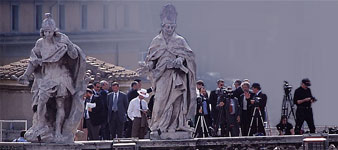.
.

.
.Facultad
de Comunicación
Institucional
|
|
COMUNICACIONES
The Interregnum and The Da Vinci Code: Case Studies in Effective Communications
Lisa Wheeler
Executive Vice President, Maximus Media Group
lwheeler@maximusmg.com
www.maximusmg.com
In Rapid Development, Pope John Paul II reminds us that Ours is an age of global communications in which countless moments of human existence are either spent with, or at least confronted by, the different processes of the mass media. There is little doubt in 2006 that the modern media has become a powerful force. Pictures of flood victims in the Far East can unleash a globalcall-to-action and engage our churches and communities to respond. But this same media can lead our culture in the opposite direction. With clever selection of sound-bytes, it can distort the truth, persuading much of a nation that death by starvation is "merciful", as in the case of America's Terri Schiavo.
The media can make or break groups and organizations: it can fuel grassroots movements like "Promise Keepers" or products like "The Purpose-Driven Life", but it can also weaken or even destroy mighty institutions and corrupt those messages promoting faith, life and family values. In short, the mass media is a force to be reckoned with. It is a tool that must be harnessed to work for the fundamental messages of the Gospel.
In this paper and presentation, we will demonstrate how the Church can assemble strategies and create relationships with the media in order "to facilitate the communication of the Gospel and render the bonds of communion among ecclesial communities more effective" (Rapid Development, 6). We will illustrate how communications offices can accomplish this through the example of two important case studies:
1. Responding to the global interest in the life and legacy of John Paul II, the interregnum period in the Catholic Church and the subsequent election of Pope Benedict XVI, we will demonstrate how advance communication preparation and established relationships with a variety of media outlets led to favorable and comprehensive coverage of the Catholic Church. Topics commonly of interest to faithful Catholics and Christians, but often debated in the popular culture were openly discussed on major television and radio networks and covered in most mainstream print publications. Communications offices can be prepared with simple media action plans for both proactive (as in the case of known events, like a Bishop's release of a Pastoral Letter), or reactive (as in the case of an unexpected circumstance, like the death of a well-known local figure) situations.
2. On May 19th, The Da Vinci Code will be released as a major motion picture. Film critics have predicted it will be one of the year's biggest blockbusters. The fact is that millions of people, who are not experts in history, art, theology, or archeology, are going to be duped by The Da Vinci Code's fraudulent assertions and invented history. This media event will certainly be damaging to the reputation of the Catholic Church, and to the faith of millions. We will provide practical ways communications offices can turn what could be perceived as a terrible blow to Christianity into an opportunity to engage their diocesan communities in effective evangelization.
back |



